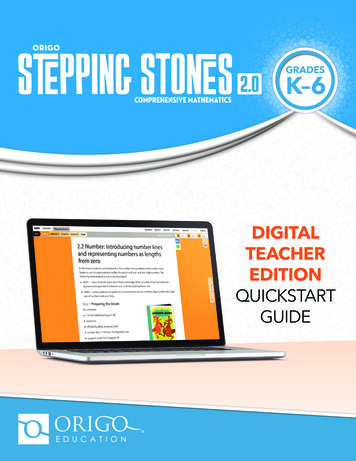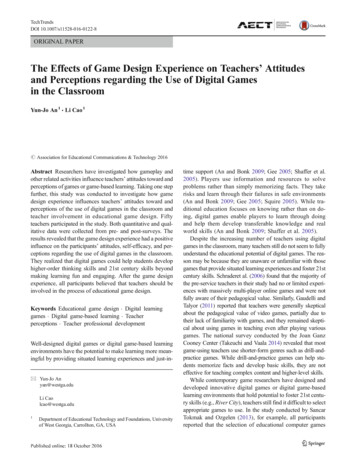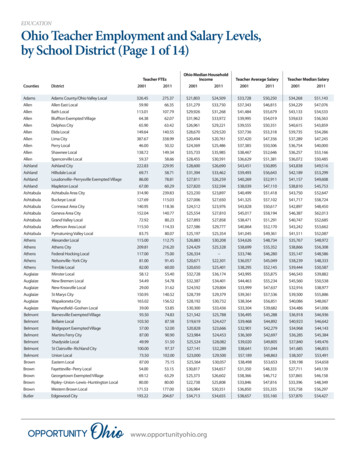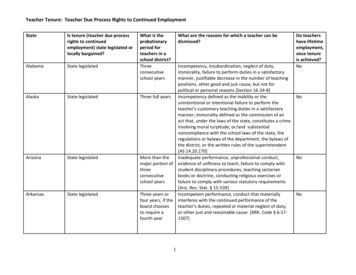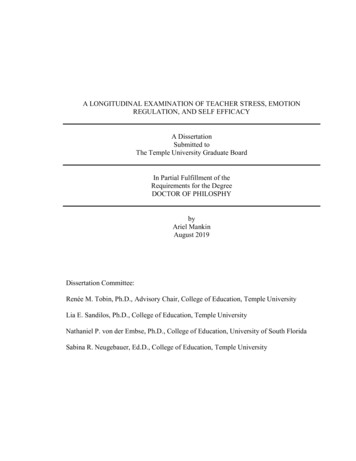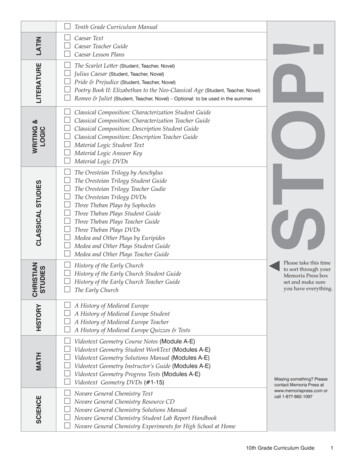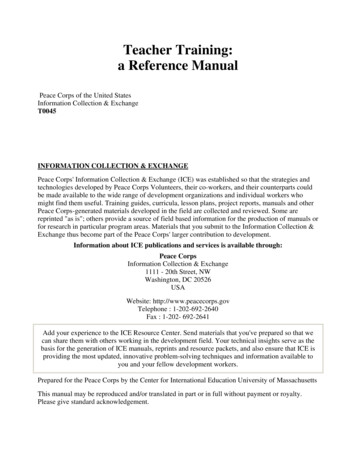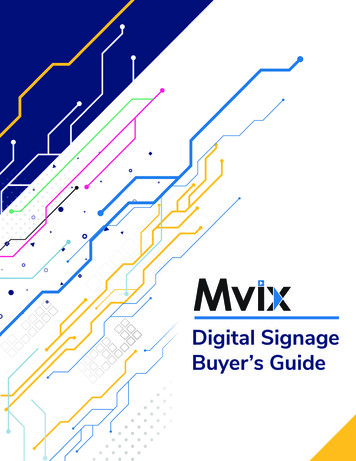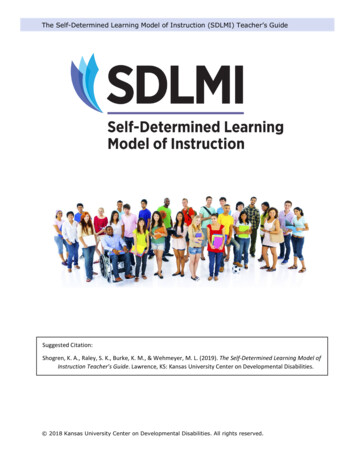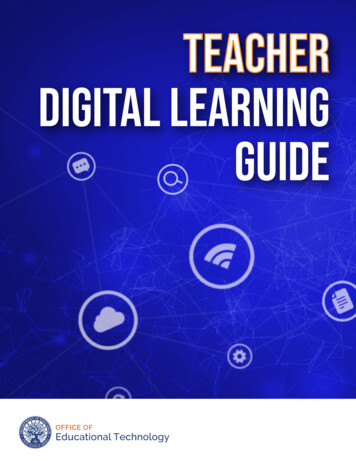
Transcription
TeacherTeacherDigitalDigital LearningLearningGuide
Other than statutory and regulatory requirements included in the document, the contents ofthis guidance do not have the force and effect of law and are not meant to bind the public. Thisdocument is intended only to provide clarity to the public regarding existing requirements underthe law or agency policies. [OET-FY21-02]TABLE OF CONTENTSAcknowledgements . 3Introduction. 5Access, Digital Citizenship & Safety, and Privacy & Security. 61. ADDRESSING ACCESS. 62. TEACHING DIGITAL CITIZENSHIP & SAFETY. 73. ENSURING PRIVACY & SECURITY. 8Personalize Learning for Students.111. EMPOWERING THE INDIVIDUAL LEARNER. 112. FOSTERING STUDENT ENGAGEMENT.133. DEVELOPING AGENCY AND SELF-DIRECTED DIGITAL LEARNING.174. OPTIMIZING ASSESSMENTS USING DIGITAL LEARNING. 18Collaborate with Parents and Families to Support Students. 211. COMMUNICATING WITH PARENTS & FAMILIES.212. SETTING EXPECTATIONS AND SUPPORT FOR STUDENT PARTICIPATION. 233. SUPPORTING SOCIAL AND EMOTIONAL NEEDS OF STUDENTS. 25Teacher Professional Learning and Well-being.28Navigating the Future. 31Endnotes .32Digital Learning Guide Teacher2
ACKNOWLEDGEMENTSThis work was developed under the guidance of senior staff in the U.S. Department of Education,Office of Educational Technology with technical support from Pia Dandiya, Jessenia Guerra,Michael Ham, Kevin Johnstun, and Maile Symonds and contributions from Digital Promise.The team extends their thanks to a Technical Working Group of education leaders andresearchers who provided valuable insights and examples from their experience (listed inalphabetical order by last name):Jose Blackorby, CASTJered Borup, George Mason UniversityLinda Burch, Common Sense MediaJon Deane, GreatSchoolsPete Just, Metropolitan School District of Wayne TownshipSarah Pottle, The New Teacher ProjectBeth Rabbitt, The Learning AcceleratorJustin Reich, Massachusetts Institute of TechnologyValerie Truesdale, American Association of School AdministratorsLEGAL DISCLAIMERThis document contains resources that are provided for the user’s convenience. The inclusionof these materials is not intended to reflect their importance, nor is it intended to endorse anyviews expressed, or products or services offered. These materials may contain the views andrecommendations of various subject matter experts as well as hypertext links, contact addressesand websites to information created and maintained by other public and private organizations.The opinions expressed in any of these materials do not necessarily reflect the positions orpolicies of the U.S. Department of Education. The U.S. Department of Education does not controlor guarantee the accuracy, relevance, timeliness, or completeness of any outside informationincluded in these materials. For the reader’s convenience, this document contains examples ofpotentially useful information. Inclusion of trade names, commercial products, commodities,services, or organizations does not constitute an endorsement nor a preference for theseexamples, as compared with others that might be available and be presented, by the Departmentor the U.S. government. Additionally, the discussion herein does not imply an endorsement ofany curriculum or learning model. The Department does not in any way direct or control anycurriculum or learning model.Digital Learning Guide Teacher3
WHAT CAN THIS GUIDE DO FOR YOU?This guide is designed to provide important resources and recommendations tosupport teacher implementation of digital learning. Digital learning is defined as“any instructional practice that effectively uses technology to strengthen a student’slearning experience and encompasses a wide spectrum of tools and practices.”1Sections in this guide include key considerations, guiding strategies, resources, andreflection questions to help guide your thinking and planning in a way that will bespecific to your unique situation and the unique needs of your students.This “Teacher Digital Learning Guide” is part of a series of guides including the“Parent and Family Digital Learning Guide” and “School Leader Digital LearningGuide” intended to support teachers, parents, families, and leaders in leveraging thecapabilities of digital tools and resources for teaching and learning.Digital Learning Guide Teacher4
INTRODUCTIONDigital learning and its supportive technology can help you as a teacher advance learning,mitigate learning loss, and create opportunities for social and emotional engagement. Thesebenefits are possible when you and your students are in the classroom and when you areteaching students who are learning at home. To achieve these goals, access to devices and theinternet must be available for you and all your students, and digital learning should be as nimbleand accountable as possible.When school buildings closed across the country in the spring of 2020, there were varyingapproaches and levels of success in transitioning from an in-person classroom to a remotelearning environment. Schools that were able to ensure all students had access to technologyhad many more options for staying connected and supporting students, parents, and families.In order to achieve the promise of digital learning, each of your students (and you!) needaccess to a device, the internet, digital tools and resources, and the skills, norms, and practicesto ensure digital learning is empowering, engaging, and productive. While the pandemic hasbeen challenging and uncertain, it has also provided an opportunity to rethink our approach toeducation and strengthen the partnership among parents, families, teachers, and leaders to bestserve our nation’s students.Technology can help you achieve a myriad of teaching, learning, and assessment goalsregardless of the educational environment in which you find yourself, whether virtual, fully inperson, a hybrid of the two, or an alternative approach, such as pandemic pods or micro schools.This guide will help you understand how to use educational technology (EdTech) to support fourkey goals:1. Access, Digital Citizenship & Safety, and Privacy & Security: Empowering students with themindsets and skills needed to responsibly use devices and meaningfully, safely, and securelyengage in digital learning.2. Personalize Learning for Students: Meeting individual students’ needs through EdTechsupported personalized learning.3. Collaborate with Parents and Families to Support Students: Engaging parents as fullpartners in their child’s success and connect with students in a virtual, hybrid, or in-personlearning environment.4. Teacher Professional Learning and Well-Being: Building pathways to continually learn andrefine strategies for using technology to its fullest potential.In each section, you will find tips, resources, and questions to help you make the best use ofEdTech to support students and learn new skills to add to the timeless educator attributes ofcreativity, caring for students, and ensuring love of learning.Digital Learning Guide Teacher5
THIS SECTION IN 30 SECONDSIn a digital learning environment, students need access to devices, internetconnectivity, and skills to support optimal learning. Before implementingdigital learning, you should consider how to close digital divides, teachdigital citizenship, and maintain privacy and security for the student datacreated by digital learning tools.ACCESS, DIGITAL CITIZENSHIP &SAFETY, AND PRIVACY & SECURITY1. ADDRESSING ACCESSKey ConsiderationsBefore a student can meaningfully engage in digital learning, theyneed access to a device and the internet. As a professional on thefrontlines of an educational landscape that is increasingly digital, it isimportant for you to have a current understanding of what technologytools are available, what your school can and does provide, and whatyour families can access. Consider how to be prepared and build in sustainableflexibility based on variations in what your school may provide and what your students canaccess.Additionally, you may need an understanding of your school or district’s policies on softwareselection and use, resource sharing and tracking, inventory, and any insurance coverage ofdevices. If you are involved in the selection and evaluation of software for learning, considerthoroughly vetting tools by conducting rapid-cycle tech evaluations (RCE), 2 and consultingevidence-based product certifications from non-profit organizations such as Common SenseMedia, International Society for Technology in Education (ISTE), and Digital Promise.Guiding StrategiesIn collaboration with your school or district: Take inventory through survey or other means of student access and establish aprocess for monitoring changes to access. Inform parents and families of local options for home internet access, and provideschool or school system resources about free or low-cost home internet serviceoptions in their area or through resources such as the Federal CommunicationsCommission’s Lifeline program, the non-profit EveryoneOn, or the National DigitalInclusion Alliance. Coordinate with school system personnel to understand the current timelines andsystems for procurement and maintenance of district devices and options for internetaccess and technical support and ensure that both families and students know whereto direct questions.Digital Learning Guide Teacher6
Reflect upon the needs of your students and ask your school or school system criticalquestions before adopting and using a tool to understand, for example, what internetspeed is required for the tool to work properly, whether content can be accessed ordownloaded offline, if the tool can be easily used on mobile devices, and the extentto which the tool meets accessibility standards for the unique needs of each learner(e.g., whether it is compatible with assistive technology software such as screenreaders, whether it includes captions for videos).2. TEACHING DIGITAL CITIZENSHIP & SAFETYKey ConsiderationsAlthough students may use technology in their personal lives, they may not yet have developedthe awareness, dispositions, or skills to be responsible and ethical digital citizens. Good digitalcitizenship refers to the behaviors and actions students need to safely, ethically, and responsibly: navigate and participate online; exhibit critical thinking and problem-solving skills; know and understand their rights; evaluate online information for accuracy and trustworthiness; and take ownership of their privacy and digital presence.Therefore, as students access the tools needed for digital learning, it is important that they areequipped with the knowledge and understanding of digital citizenship practices.As a key facet of digital citizenship education, it is important to focus on student safety in thedigital space and to incorporate material designed to teach students about an increasinglydigital world. This focus will provide them the skills needed to protect their digital identity,develop appropriate communication skills and positive relationships, protect themselves fromcyberbullying and potential predators, and understand the mental health and wellness aspectsof screen time and making good choices online. You have an important role in helping studentssafely participate, learn, and create in a digital environment.Developing your students’ digital citizenship skills will require professional learning, intentionallearning environment design, and collaboration with their parents and families. As the primaryeducators of their students, parents and families are essential to successful digital citizenship skillacquisition. Just as you may need additional resources to navigate this transition, your students’parents and families will likely need the same and supporting them will help you leverage themas partners.Guiding Strategies and Resources Build your own understanding of digital citizenship by exploring resources likeCommon Sense Media’s Inside The 21st-Century Classroom report on EdTech usageby K-12 teachers with their students and observations on its impact on learning;materials from ISTE, including access to ISTE’s virtual digital citizenship coursefor K-12 teachers; and other resources, such as the materials for teachers, parents,and communities available through the National Center for Missing and ExploitedChildren. Familiarize yourself with general guidance on screen time for the age group youteach, and best practices for screen time during remote learning.Digital Learning Guide Teacher7
Recognize that the quality of screen time is more important than the amount ofscreen time, and share guidance with students, parents, and families. Embed digital citizenship skills into your lessons. Help your students learn aboutsafety and privacy issues including how to manage their online identity andreputation, how to identify and report suspicious behaviors or incidents, and how toprotect their personal information. Utilize ready-made lesson plans such as the free lesson plan materials from CommonSense Media and curricula materials available at CYBER.ORG, work which isfunded through the U.S. Department of Homeland Security’s Cybersecurity andInfrastructure Security Agency (CISA). Learn about cyberbullying from the Federal Commission on School Safety andunderstand the forms of cyberbullying, as well as the laws and policies and how tostop cyberbullying. Although cyberbullying often takes place outside of classrooms(and virtual classrooms), be cautious about incorporating classroom EdTech tools thatallow peer-to-peer conversations that are not accessible and monitored. Explore the FBI’s Safe Online Surfing modules for third through eighth graders. Host parent and family workshops, either in person or online, or develop othercreative solutions to help them navigate digital learning tools in ways that promotetheir students’ digital citizenship.3. ENSURING PRIVACY & SECURITYKey ConsiderationsYou have an important role in protecting the privacy and security of student data online.Students increasingly share personal information online through activities like signing up foraccounts. As a result, data about them is collected by devices, internet algorithms, companies,and third parties, which is then at risk to misuse or abuse.With increased technology comes the need for increased vigilance to protect student privacy.Your school’s leadership should provide devices and EdTech tools that have already beenproperly vetted. Alternatively, your school may have guidance on vetting and adopting toolsthat meet privacy and security obligations, in accordance with federal law, for the classroomand home access. Make sure you are familiar with available resources that may be shared to helppartner with, and educate, parents to keep their students’ information safe.Reference the “Parent and Family Digital Learning Guide” for information on empowering parentsin their role in digital learning and working with parents to protect the privacy and security ofstudents.Digital Learning Guide Teacher8
Federal Laws Governing Privacy and Safety: FERPA, IDEA, and COPPAThe Family Educational Rights and Privacy Act, known as FERPA, is a federal law that, whereapplicable, among other things, generally prohibits FERPA-covered educational agencies (e.g.,school districts) and institutions (e.g., schools) from disclosing personally identifiable information(PII) from the education records of a student without the prior written consent of the student’sparent or the “eligible student” herself or himself (i.e., the student if he or she is 18 years orolder or attends an institution of postsecondary education). 20 U.S.C. §§ 1232g(b), (h), (i), and(j), and 34 CFR Part 99, Subpart D. FERPA contains specific exceptions to this general consentrequirement that are set forth in 20 U.S.C. § 1232g(b)(1)-(b)(3), (b) (5), (b)(6), (h), (i) and (j),and 34 CFR § 99.31. FERPA also generally provides parents and eligible students with the rightto inspect and review their education records, and the right to seek to amend information intheir education records that is inaccurate, misleading, or in violation of the student’s rightsof privacy. 20 U.S.C. §§ 1232g(a)(1)(A) and (a)(2), and 34 CFR Part 99, Subparts B and C. Formore information regarding FERPA, please visit the U.S. Department of Education’s StudentPrivacy Policy Office’s website at https://studentprivacy.ed.gov. Of note, the U.S. Department ofEducation released guidance to parents on FERPA in April 2020 titled, “The Family EducationalRights and Privacy Act: Guidance for Parents,” which is available at https://studentprivacy.ed.gov/ sites/default/files/resource document/file/FERPAGuidanceForParents.pdf. This wasaimed at operating during the COVID-19 emergency and in a virtual environment.The Individuals with Disabilities Education Act (IDEA), where applicable, also containsconfidentiality of information provisions that protect PII in the education records of children withdisabilities. 20 U.S.C. § 1417(c) and 34 C.F.R. §§ 300.610-300.626. IDEA also generally providesparents with the right to inspect and review their child’s education records, and the right toseek to amend information in their child’s education records that is inaccurate, misleading, orin violation of the student’s rights of privacy. IDEA’s confidentiality provisions generally requireparental consent for disclosure of PII in education records, to parties other than officials ofparticipating agencies, and generally incorporate the FERPA exceptions to the prior writtenconsent requirement. Note that the IDEA confidentiality of information provisions incorporatesome of the FERPA requirements but also include several provisions that are specifically relatedto children with disabilities. More information about IDEA and FERPA confidentiality provisions isavailable at ferpa.pdf.The Children’s Online Privacy Protection Act (COPPA), where applicable, generally givesparents control over what information is collected about their children online. Under COPPA,schools may, in certain circumstances, provide consent on behalf of parents to the collection ofstudent personal information. The Federal Trade Commission recently clarified that “schools canconsent on behalf of parents to the collection of student personal information—but only if suchinformation is used for a school-authorized educational purpose and for no other commercialpurpose. This is true whether the learning takes place in the classroom or at home at thedirection of the school.” More information about COPPA is available at uringcoronavirus.Digital Learning Guide Teacher9
Guiding Strategies and Resources ConnectSafely.org provides information on district policies and professionalstandards related to social media communications with parents, families, andstudents, and Edutopia.org provides the resource, How to Create Social MediaGuidelines for Your School. A best practice is to make your professional accounts for email and socialmedia separate from your personal ones. Refrain from saying anything online that you would not say in class; be evenmore careful, as online interactions lack context and tone, and, as a result, maybe easily misinterpreted. Examine how your students manage passwords. Some school systems support asingle sign-on strategy. If this is not the case, think about strategies for managing howstudents will create and keep track of multiple logins and passwords (e.g., recordingall information in one place, either physical or digital). Make sure parents and familiesare familiar with the process, as appropriate. Learn about federal regulations, guidance, and best practices on student privacy atthe Department’s Student Privacy Policy Office website.REFLECTION QUESTIONS:ADDRESSING ACCESS, TEACHING DIGITAL CITIZENSHIP & SAFETY,AND ENSURING PRIVACY & SECURITYPlanning and Assessment: Do my students and their parents and families have access to the tools needed forsupporting effective digital learning at home? If not, how can I facilitate their access? What data are collected and shared by the provider when the student uses oraccesses the tools I am using in my teaching? Is data deleted and when is it deleted? Could the data collected by the provider be used to disadvantage students in thefuture, such as when they apply for college or jobs? What steps can I take to help identify and prevent cyberbullying? What district guidelines and resources are in place to ensure compliance withapplicable privacy laws, regulations, and policies?Teaching and Learning: How will I teach students to use new tools, ensure they can access technologysupport if they have trouble with the tool, provide opportunities for practice, andshare expectations for its use? How do I plan to teach and model digital citizenship skills for my students?Communication: How can I work best with my students’ families to exchange best practices andresources for access, digital citizenship and safety, and privacy and security? Mycolleagues? My school leadership?Digital Learning Guide Teacher10
THIS SECTION IN 30 SECONDSPersonalizing learning can promote students’ behavioral, cognitive,emotional, and relational engagement; foster student agency (i.e., studentinitiative, intention, and responsibility in pursuing their education); providedata that can be used to differentiate learning to meet each student’sindividual needs; and optimize assessment to best document studentprogress.PERSONALIZE LEARNING FORSTUDENTSClassroom learning has changed, quickly. Learning is nowoccurring in a variety of environments—synchronous,asynchronous, hybrid and virtual formats, school closures, andlimited or rolling grade-level openings—with each impacting thelearning experience of students. The current environment hascreated the demand to support students by leveraging EdTech andtools to empower the individual learner, foster engagement, developagency and self-directed digital learning, and optimize assessments.1. EMPOWERING THE INDIVIDUAL LEARNERDigital learning and technology can move you toward meeting the needs of each student andproviding an individualized approach to education. Tailoring support to each student’s strengths,interests, learning styles, and time considerations allows for empowering the individual learner byfocusing on their competencies and enabling real-time assessment.Key ConsiderationsOnce you have considered whether students have access to learning materials and resourcesto support digital citizenship, you can focus on leveraging EdTech to address your students’individual learning needs. Digital technologies, including assistive technologies, can empowerDigital Learning Guide Teacher11
students to become drivers of their own learning, deeper thinkers, and stronger collaborators.EdTech can also provide you with supports for personalizing learning by allowing you to tailorassignments that address student interests, creating options for student choice and providingjust-in-time feedback.Guiding Strategies and Resources Recognize that your students bring their unique traits and characteristics to theirlearning circumstances; that includes things such as neurodiversity, disabilities,gender, culture, ethnicity, economic status, English language learning status, andmore. Personalize learning by meeting the needs of individual students; tailor assignmentsto their needs, interests, and differences, and provide them with choices. Assess whether additional supports or resources are needed for your students toaddress any learning losses or gains that may have occurred, mitigate future learninglosses, and build upon gains. Use EdTech tools to support personalization in multiple ways such as through apps,adaptive environments and problem sets, the availability of myriad topics of intereston the internet, games and simulations, the use of tools for creativity and selfexpression, and the ability of students to develop and maintain their own portfolios. Examples of these tools developed with the support of the Institute ofEducation Sciences (IES) include: Math: NumberShire, Teachley, Querium’s StepWise Virtual Tutor,ASSISTments Science: ChemVLab , Happy Atoms English Language Arts: A2i Platform, Moby.Read, MOCCA English Learners: Uno, Dos, Tres, Listos!, STORYWORLD, Enfoque en Ciencia Social and Behavioral Development: SELweb Early Childhood: Molly of Denali, Individual Growth & DevelopmentIndicators, Cognitive ToyBox for Schools Special Education: EdMod, KinderTEK, Go Phonics, Future Quest Island Classroom Discourse: Class 5.0 Personalize learning for students with disabilities by ensuring they have access toinstructional materials, aids and services, and assistive technologies that are tailoredto their specific needs as identified in their Individualized Education Programs (IEPs).3 Familiarize yourself with information about the early impacts of COVID-19, likethis report from the Government Accountability Office (GAO) to Congress on thedistance learning challenges in providing services to K-12 English Language Learningstudents and students with disabilities. (GAO 21-43)Digital Learning Guide Teacher12
REFLECTION QUESTIONS:EMPOWERING THE INDIVIDUAL LEARNERPlanning and Assessment: Have I reviewed the learning strengths, weaknesses, and needs of my students—bothacademic and technological—to understand and prepare content, tools, and supportsaccordingly? In making instructional plans and selecting curricular materials, to what extent amI making decisions to empower all students, while keeping the most vulnerablepopulations in mind? How does my district account for the digital delivery and support of legally requiredneeds, goals, and services for students with disabilities?Teaching and Learning: How am I basing learning personalization on data, and what is the source of thesedata?4 To what extent is research available to support the efficacy of the personalizedlearning tools that I am considering using for my students? Do I have a student or students who I think should be assessed for extra services,special education needs, or both—and if so, how do I ensure that happens? What additional supports or resources are available for my students to address anylearning loss that may have occurred and to mitigate future learning loss?Communication: How can I work best with my students’ families to exchange best practices andresources regarding personalized learning? My colleagues? My school leadership? Have I communicated and connected parents and families to additional supports orresources available for my students to both meet their different learning needs and toaddress any learning loss?2. FOSTERING STUDENT ENGAGEMENTKey ConsiderationsDigital technologies can be powerful tools to help foster student engagement. Engagingstudents, either in-school or virtually, includes: supporting their social and emotional development; fostering relationships with you and classmates; partnering with parents, involving families; building practices such as personalization; and giving consistent feedback.Digital Learning Guide Teacher13
Learner engagement is made up of multiple components: behavioral, emotional, relational, andcognitive. In your planning, think about how to engage students in different ways.Behavioral EngagementBehavioral engagement considers student effort and participation in activities. The use ofEdTech in digital environments provides the opportunity to be responsive to students’ behaviors.EdTech can yield reports that include the number of interactions with course materials,assignment completion rates, or the extent to which each student participated in virtualdiscussions and other synchronous sessions.Guiding Strategies and Resources Develop a method for tracking student digital participation using the data reportedby your digital learning tools. Many provide login counts, number of posts, andnumber of interactions with materials (number of clicks a student makes). Determine what digital participation data are most informative and follow up withstudents who do not meet your participation goals. Foster student engagement by tapping into research to increase engagement duringremote lear
curriculum or learning model. Digita earnin uid eacher 4 . person, a hybrid of the two, or an alternative approach, such as pandemic pods or micro schools. This guide will help you understand how to use educational technology (EdTech) to support four . and maintain privacy and security for the student data created by digital learning tools .
